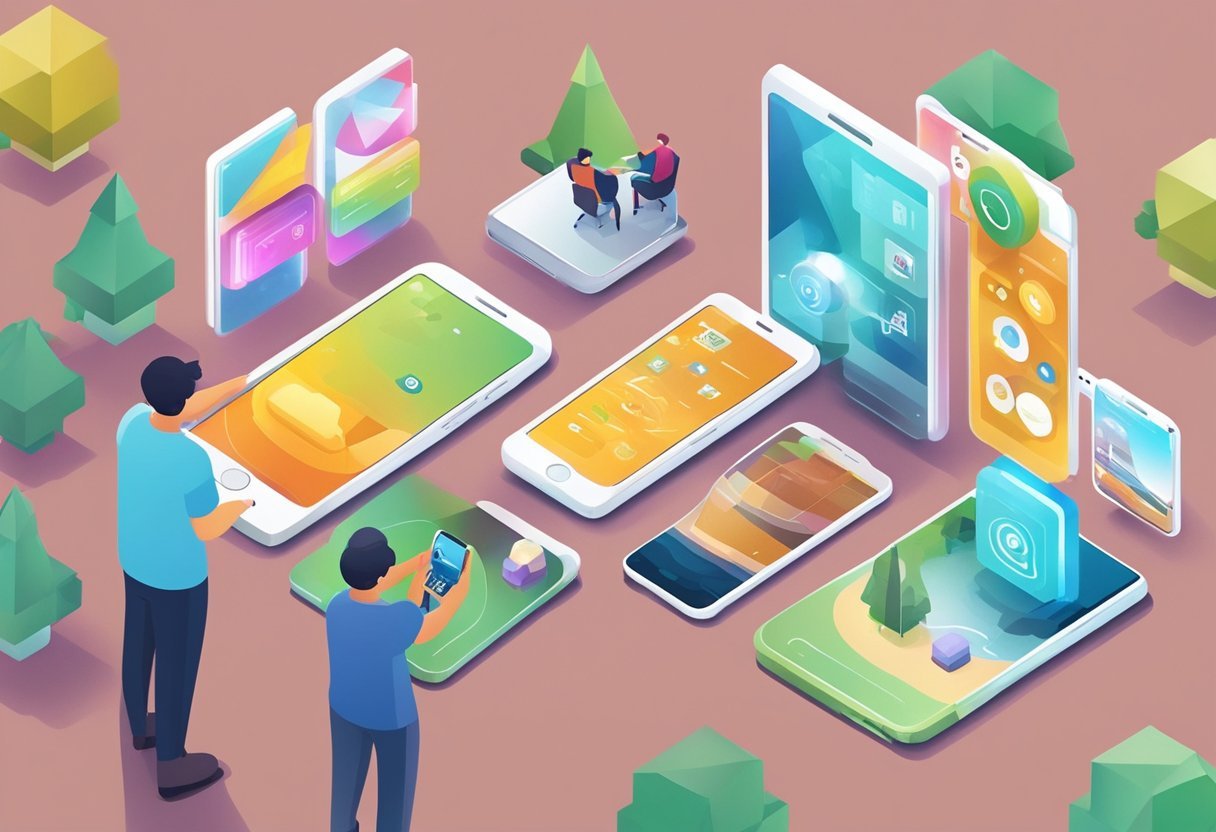Augmented reality (AR) is a technology that overlays digital information onto the real world. It is a technology that has been around for a while, but it has only recently become more accessible to the general public. AR software is the backbone of this technology, and it is what makes it possible to create and view AR experiences. In this blog post, I will share with you what is augmented reality software, how it works and the functionalities and use cases of augmented reality software.
AR software is used to create and manipulate digital content that can be overlaid onto the real world. It is a combination of programming languages, tools, and libraries that allows developers to create AR experiences. There are many different types of AR software available, ranging from simple tools for creating basic AR experiences to more complex software that can be used to create highly immersive experiences.
AR software is used in many different applications, from entertainment to education to healthcare. It is used to create immersive experiences that engage users and allow them to interact with the digital world in new and exciting ways. As the technology continues to evolve, it is likely that we will see even more innovative uses of AR software in the future.
Key Takeaways
- Augmented reality software is the backbone of AR technology and is used to create and manipulate digital content that can be overlaid onto the real world.
- AR software is used in many different applications, from entertainment to education to healthcare.
- As the technology continues to evolve, we can expect to see even more innovative uses of AR software in the future.
Concept of Augmented Reality

The Basics of AR
Augmented Reality (AR) is an immersive technology that overlays digital information onto the real world in real-time. This technology enhances the user’s experience by providing an interactive and engaging environment. AR is different from Virtual Reality (VR) because it doesn’t create a completely artificial environment. Instead, it enhances the user’s experience by adding digital information to the real world.
AR technology works by using a camera-equipped device, such as a smartphone, tablet, or smart glasses, and AR software. The device captures the real-world environment and overlays digital information on top of it. This digital information can include images, videos, 3D models, and more. AR technology can also use sensors, such as GPS, accelerometers, and gyroscopes, to provide contextual information to the user.
AR vs. VR and the Metaverse
AR and VR are often compared, but they are different technologies. VR creates a completely artificial environment that immerses the user in a digital world. AR, on the other hand, enhances the real world by overlaying digital information onto it. The Metaverse is a term used to describe a future version of the internet, where virtual and real-world experiences are seamlessly integrated. AR and VR are both expected to play a significant role in the development of the Metaverse.
AR technology has many applications, including gaming, education, marketing, and healthcare. For example, AR can be used in gaming to provide an immersive and interactive experience, while in education, it can be used to provide visual aids and enhance learning. In marketing, AR can be used to create engaging and interactive advertisements, while in healthcare, it can be used to train medical professionals and assist in surgeries.
AR is an immersive technology that enhances the user’s experience by overlaying digital information onto the real world in real-time. AR is different from VR because it doesn’t create a completely artificial environment. AR and VR are both expected to play a significant role in the development of the Metaverse. AR technology has many applications, including gaming, education, marketing, and healthcare.
Augmented Reality Software

Augmented Reality (AR) software is a type of software that allows users to overlay digital content onto the real world. AR software is used in various fields, including gaming, education, and marketing. AR software has gained increasing popularity in recent years, and it is expected to continue to grow in the future.
Core Features of AR Software
AR software has several core features that make it unique. Some of these features include:
- Real-time interaction: AR software allows users to interact with digital content in real-time, creating a more immersive experience.
- Integration with real-world objects: AR software can integrate with real-world objects, allowing users to interact with them in new ways.
- Multi-platform support: AR software can be used on multiple platforms, including mobile devices, tablets, and desktop computers.
- Tracking and mapping: AR software can track and map real-world objects, allowing users to interact with them in a more natural way.
Popular AR Software Platforms
There are several popular AR software platforms available today, including:
- Unity: Unity is a popular game engine that includes AR functionality. It is used by developers to create AR applications for mobile devices and other platforms.
- ARKit: ARKit is a framework developed by Apple that allows developers to create AR applications for iOS devices.
- Google Glass: Google Glass is an AR device that allows users to interact with digital content in the real world. It has been used in various fields, including healthcare and manufacturing.
AR software development tools such as Vuforia, ARCore, and ARToolKit are also popular among developers. AR software has become an increasingly popular technology that has a wide range of applications. With the increasing demand for AR applications, it is expected that AR software will continue to evolve and become even more powerful in the future.
Hardware for Augmented Reality

Augmented Reality (AR) is a technology that superimposes digital information onto the real world. To achieve this, AR requires hardware that can capture and process real-world data and display the digital information in a way that appears to be part of the real world. In this section, we will discuss the hardware required for AR, including smartphones and tablets, smart glasses and headsets.
Smartphones and Tablets
Smartphones and tablets are the most common hardware used for AR applications. They have high-quality displays and sensors that can capture and process real-world data. The AR software can use the camera on the smartphone or tablet to capture the real-world environment and superimpose digital information on it. The sensors in the smartphone or tablet can also detect the orientation of the device and track its movement, allowing the AR software to adjust the digital information accordingly.
Smart Glasses and Headsets
Smart glasses and headsets are another type of hardware used for AR applications. They are designed to be worn on the head and have displays that are positioned in front of the eyes. The displays can be transparent or opaque, depending on the type of AR application. Smart glasses and headsets also have sensors that can detect the orientation of the device and track its movement.
Smart glasses and headsets are more immersive than smartphones and tablets, as they provide a more natural viewing experience. They are also hands-free, which makes them ideal for applications where the user needs to interact with the digital information while performing other tasks.
The hardware required for AR includes smartphones, tablets, smart glasses, and headsets. Each type of hardware has its own advantages and disadvantages, and the choice of hardware depends on the specific application requirements. Smartphones and tablets are more common and accessible, while smart glasses and headsets provide a more immersive experience.
Applications of AR Software

AR software has a wide range of applications across various industries, including gaming, education, retail, healthcare, and entertainment. Here are some of the most prominent uses of AR software:
AR in Gaming and Entertainment
AR has transformed the gaming and entertainment industry by providing an immersive experience to users. Games like Pokemon Go have taken the world by storm by allowing users to catch virtual creatures in the real world. AR technology has also been used in theme parks to enhance the experience of visitors by overlaying digital information onto the physical environment. AR is also used in live events to create interactive experiences for the audience.
Educational Uses of AR
AR has the potential to revolutionize the education industry by providing interactive and engaging content to students. AR can be used to create virtual models of complex concepts, making them easier to understand. For example, AR can be used to create virtual models of the human body, allowing students to explore the different organs and systems in a fun and interactive way. AR can also be used to create virtual field trips, allowing students to explore different parts of the world without leaving the classroom.
AR in Retail and E-commerce
AR is increasingly being used in the retail and e-commerce industry to provide a better shopping experience to customers. AR can be used to create virtual try-on experiences, allowing customers to see how different products look on them before making a purchase. AR can also be used to provide product information and reviews, helping customers make informed purchasing decisions. Retailers can also use AR to create interactive displays and advertisements, attracting more customers to their stores.
Industrial and Healthcare Applications
AR is also being used in industrial and healthcare applications. AR can be used to provide real-time information to workers in industrial settings, helping them to perform tasks more efficiently and safely. AR can also be used in healthcare to provide real-time information to doctors and nurses, helping them to make better decisions and provide better care to patients. AR can also be used to create virtual simulations of medical procedures, allowing doctors to practice and perfect their skills without putting patients at risk.
AR software has a wide range of applications across various industries, providing an immersive and interactive experience to users. As AR technology continues to evolve, we can expect to see even more innovative uses of AR in the future.
Creating Augmented Reality Experiences
Augmented reality software allows developers to create immersive experiences that blend the digital and physical worlds. This section will cover the design and development tools and environments required to create AR experiences.
Designing for AR
Designing for AR is very different from designing for traditional 2D screens. In AR, the user’s environment is the canvas, and the designer must consider how digital objects will interact with the real world. AR designers must also consider how users will interact with AR objects and how these objects will respond to user input.
To create AR experiences, designers use 3D modeling software to create digital objects that will be placed in the real world. Designers must also consider lighting, shadows, and object detection to ensure that digital objects appear as though they are part of the real world.
Development Tools and Environments
Developers use a variety of tools and environments to create AR experiences. AR development tools include Unity, Unreal Engine, and ARKit. These tools provide developers with the ability to create 3D models, add animations and interactivity, and integrate machine learning and computer vision algorithms.
AR environments include mobile devices such as smartphones and tablets, as well as AR headsets such as the Microsoft HoloLens and Magic Leap. AR environments allow users to experience AR content in a more immersive way, and developers can create experiences that take advantage of the unique capabilities of each device.
Creating AR experiences requires a combination of design and development skills, as well as specialized tools and environments. By understanding the unique challenges and opportunities of AR, designers and developers can create experiences that are both engaging and immersive.
User Interaction and Experience

Enhancing User Engagement
Augmented reality (AR) software enhances user engagement by creating an immersive experience that combines the real world with virtual elements. By using AR, users can interact with digital objects in a way that feels natural and intuitive. This level of engagement can be particularly effective in fields such as education, advertising, and gaming.
AR software can also provide users with a sense of ownership and control over the virtual objects they interact with. This can lead to a more satisfying experience for users, as they feel like they are actively shaping the virtual world around them.
Sensory Inputs and Outputs
AR software relies on sensory inputs and outputs to create an immersive experience for users. Sight and sound are the most commonly used inputs, but other sensory information can also be incorporated, such as touch and smell.
Input devices such as cameras and microphones are used to capture sensory information from the user’s environment, while output devices such as screens and speakers are used to display and play back digital content. AR software can also use haptic feedback to enhance the user’s experience. Haptic feedback provides physical sensations that correspond to digital events, such as vibrations or pressure changes.
AR software provides a unique and engaging user experience that combines the real world with virtual elements. By using sensory inputs and outputs, AR software creates an immersive experience that can be tailored to the needs of the user.
The Future of Augmented Reality Software
Augmented Reality (AR) is a rapidly growing technology that has the potential to revolutionize the way we interact with the world around us. The future of AR software is promising and exciting, with many new innovations and trends on the horizon.
One of the most significant trends in the future of AR software is the development of mixed reality (MR) technology. MR combines the best of both virtual and real worlds, allowing users to interact with digital content in a physical environment seamlessly. The technology is expected to be a game-changer in various industries, including gaming, education, healthcare, and manufacturing.
Another promising trend in the future of AR software is the development of wearable computers that can provide users with a hands-free AR experience. These devices are expected to be smaller, more powerful, and more comfortable to wear than current AR headsets, making them more accessible to a broader audience.
The future of AR software is also expected to see the rise of digital twins. Digital twins are virtual replicas of physical objects or systems that can be used to simulate and optimize real-world scenarios. The technology has the potential to revolutionize various industries, including construction, manufacturing, and healthcare.
The future of AR software is bright, with many new innovations and trends on the horizon. The development of mixed reality, wearable computers, and digital twins are just a few of the many exciting developments that are expected to shape the future of AR software. As the technology continues to evolve and mature, we can expect to see many new and exciting applications of AR in various industries.
Frequently Asked Questions

How is augmented reality software utilized in various industries?
Augmented reality software has been utilized in various industries, including healthcare, retail, education, and entertainment. In the healthcare industry, AR technology has been used to train medical students and assist surgeons during complex procedures. In retail, AR technology has been used to enhance the shopping experience by allowing customers to try on clothes and visualize furniture in their homes before making a purchase.
In education, AR technology has been used to create interactive textbooks and enhance classroom learning. In entertainment, AR technology has been used to create immersive experiences in video games and theme parks.
Can you provide examples of augmented reality software in action?
Yes, there are several examples of augmented reality software in action. One popular example is the Pokemon Go game, which allows users to catch virtual creatures in the real world using their smartphones. Another example is the Ikea Place app, which allows users to visualize furniture in their homes before making a purchase.
In the healthcare industry, the AccuVein device uses AR technology to help medical professionals locate veins during procedures. In the education industry, the Anatomy 4D app allows students to explore the human body in 3D using AR technology.
What distinguishes augmented reality software from virtual reality technology?
Augmented reality software overlays digital information onto the real world, while virtual reality technology creates a completely immersive digital environment. AR technology enhances the real world by adding digital elements, while VR technology creates a new digital world for users to explore. AR technology requires a camera or other sensor to detect the real world, while VR technology requires a headset or other device to completely immerse the user in the virtual world.
What are the different types of augmented reality technology available?
There are two main types of augmented reality technology: marker-based and markerless. Marker-based AR technology uses a physical marker, such as a QR code or image, to trigger the digital overlay. Markerless AR technology uses sensors, such as GPS or accelerometers, to detect the user’s location and orientation in the real world. Within these two types, there are also variations such as projection-based AR and superimposition-based AR.
How does augmented reality software function to enhance user experience?
Augmented reality software enhances user experience by adding digital elements to the real world, providing users with a more interactive and immersive experience. AR technology can be used to provide additional information or context, such as displaying product information when a user points their smartphone at a product in a store. It can also be used to create interactive games or experiences, such as the Pokemon Go game.
Which platforms and tools are commonly used to develop augmented reality applications?
There are several platforms and tools commonly used to develop augmented reality applications, including Unity, Vuforia, ARKit, and ARCore. Unity is a popular game engine that can also be used to develop AR applications. Vuforia is an AR platform that provides tools for image recognition and tracking. ARKit and ARCore are software development kits (SDKs) provided by Apple and Google, respectively, for developing AR applications on their respective platforms.




